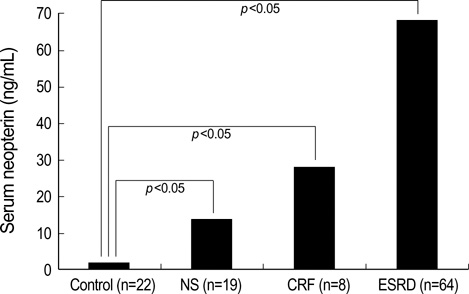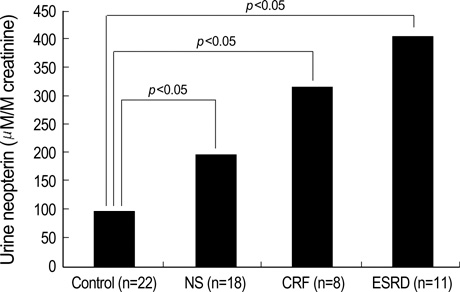J Korean Med Sci.
2006 Aug;21(4):678-682. 10.3346/jkms.2006.21.4.678.
The Clinical Significance of Serum and Urinary Neopterin Levels in Several Renal Diseases
- Affiliations
-
- 1Department of Internal Medicine, Sungkyunkwan University School of Medicine, Kangbuk Samsung Hospital, Seoul, Korea. hyang77.kim@samsung.com
- 2Department of Urology, Sungkyunkwan University School of Medicine, Kangbuk Samsung Hospital, Seoul, Korea.
- KMID: 2157820
- DOI: http://doi.org/10.3346/jkms.2006.21.4.678
Abstract
- Neopterin is a pyrazino-pyrimidine compound, and is known to be a marker associated with cell-mediated immunity in various diseases. We hypothesized that the levels of serum and urine neopterin would be elevated in renal disease, and would correlate with certain clinical parameters. We evaluated serum and urinary neopterin levels in patients with several renal diseases, including nephrotic syndrome (NS, n=19), chronic renal failure (CRF, n=8), end stage renal disease (ESRD, n=64) and controls (n=22). Serum neopterin was elevated in patients with CRF and ESRD, as compared to controls. Urinary neopterin levels were also found to be elevated in patients with CRF and ESRD, as compared to controls. Serum neopterin levels showed significant positive correlation with age, serum BUN and creatinine levels, and inverse correlation with WBC, hemoglobin, hematocrit, serum albumin and total iron binding capacity. Urine neopterin levels exhibited positive correlation with age and serum creatinine levels, and inverse correlation with WBC, hemoglobin, hematocrit, BUN and serum albumin. In conclusion, increased serum and urinary neopterin levels were found in some patients with renal disease and were correlated with certain clinical parameters.
Keyword
MeSH Terms
-
Triglycerides/blood
Radioimmunoassay/methods
Nephrotic Syndrome/blood/pathology/urine
Neopterin/*blood/*urine
Middle Aged
Male
Kidney Failure, Chronic/blood/pathology/urine
Kidney Diseases/blood/*pathology/urine
Humans
Hemoglobins/metabolism
Hematocrit
Female
Creatinine/blood
Blood Urea Nitrogen
Aged
Age Factors
Adult
Figure
Reference
-
1. Huber C, Batchelor JR, Fuchs D, Hausen A, Lang A, Niederwieser D, Reibnegger G, Swetly P, Troppmair J, Wachter H. Immune response-associated production of neopterin. Release from macrophages primarily under control of interferon-gamma. J Exp Med. 1984. 160:310–316.
Article2. Schoedon G, Troppmair J, Fontana A, Huber C, Curtius HC, Niederwieser A. Biosynthesis and metabolism of pterins in peripheral blood mononuclear cells and leukemia lines of man and mouse. Eur J Biochem. 1987. 166:303–310.
Article3. Lin CY. Urinary neopterin as a new biochemical marker for the monitoring of disease activity and prognosis in membranous nephropathy associated with hepatitis B surface antigenemia. Nephron. 1989. 53:115–120.
Article4. Godai K, Uemasu J, Kawasaki H. Clinical significance of serum and urinary neopterins in patients wth chronic renal disease. Clin Nephrol. 1991. 36:141–146.5. Park YH, Moon KH, Park KK, Cho KW, Eum SH, Kim KS, Choi KC, Kang YJ. A study of serum neopterin levels in chronic renal failure patients undergoing hemodialysis. Korean J Intern Med. 1990. 39:213–218.6. Neale J, Hill J, Cooke R, Dunbar R. Neopterin quantitation indicates participation of cell mediated immunity in human glomerulonephritis. [abstract]. Kidney Int. 1990. 37:443.7. Oda K, Arai T, Nagase M. Increased serum and urinary neopterin in nephrotic syndrome indicate cell-mediated immune dysfunction. Am J Kidney Dis. 1999. 34:611–617.
Article8. Fuchs D, Hausen A, Reibnegger G, Werner ER, Dittrich PV, Wachter H. Neopterin levels in long-term hemodialysis. Clin Nephrol. 1988. 30:220–224.9. Wachter H, Hausen A, Grassmayr K. Increased urinary excretion of neopterin in patients with malignant tumors and with virus diseases. Hoppeseyler's Z Physiol Chem. 1979. 360:1957–1960.10. Yokoyama K, Tajima M, Yoshida H, Nakayama M, Tokutome G, Sakagami H, Hosoya T. Plasma pteridine concentrations in patients with chronic renal failure. Nephrol Dial Transplant. 2002. 17:1032–1036.
Article11. Aulitzky WE, Tilg H, Niederwieser D, Riccabona G, Obendorf L, Margreiter R, Pfaller W, Huber C. Comparison of serum neopterin levels and urinary neopterin excretion in renal allograft recipients. Clin Nephrol. 1988. 29:248–252.12. Fahey JL, Taylor JM, Detels R, Hofmann B, Melmed R, Nishanian P, Giorgi JV. The prognostic value of cellular and serologic markers in infection with human immunodeficiency virus type 1. N Engl J Med. 1990. 322:166–172.
Article13. Halota W, Jaruga B, Pawlowska M. Serum neopterin and beta2-microglobulin concentration as prognostic markers of AIDS [abstract]. Pol Merkuriusz Lek. 2002. 13:126–128.14. Aulitzky W, Frick J, Fuchs D, Hausen A, Reibnegger G, Wachter H. Significance of urinary neopterin in patients with malignant tumor of the genitourinary tract. Cancer. 1985. 55:1052.15. Bichler A, Fuchs D, Hausen A, Hetzel H, Konig K, Wachter H. Urinary neopterin excretion in patients with genital cancer. Clin Biochem. 1982. 15:38–40.16. Weiss MF, Rodby RA, Justice AC, Hricik DE; Collaborative Study Group. Free pentosidine and neopterin as markers of progression rate in diabetic nephropathy. Kindey Int. 1998. 54:193–202.
Article17. Murr G, Neurauter G, Wirleitner B, Fuchs D. Neopterin to predict prognosis of infection and neoplasia. 2001. In : International Eurogin-east conference; Sept; Vilnius.18. Pecoits-Filho R, Heimburger O, Barany P, Suliman M, Fehrman-Ekholm I, Lndholm B, Stenvinkel P. Associations between circulating inflammatory markers and residual renal function in CRF patients. Am J Kidney Dis. 2003. 41:1212–1218.
Article19. Berdowska A, Zwirska-Korczala K. Neopterin measurement in clinical diagnosis. J Clin Pharm Ther. 2001. 26:319–329.
Article
- Full Text Links
- Actions
-
Cited
- CITED
-
- Close
- Share
- Similar articles
-
- Clinical Significance of Serum and Urinary Neopterin Levels in Some Renal Diseases
- Serum Neopterin Concentration in Children with Graves' Disease
- Clinical significance of urinary neopterin excretion in patients with various digestive cancers
- Elevated Serum Levels of Neopterin in Patients with Behçet's Disease
- Levels of Urinary Neopterin in Patients with Lepromatous Leprosy and Patients with Erythema Nodosum Leprosum



